D-Day June 6th, 1944 Normandy France

It was on 6th June 1944 that Operation Overlord – the long anticipated Allied invasion of Nazi-held Europe – went into action. What came to be known as the ‘D-day landings’.
On the French beaches and in those hedgerows, many making the ultimate sacrifice. Over two thousand Americans, British, Canadians, and Australians died that first day, trading their lives for a single ambition…so we could live free.
The allied commander of the D-Day invasion, Gen Dwight D Eisenhower gives the order of the Day.
“Full victory – nothing else” to paratroopers in England, just before they board their airplanes to participate in the first assault in the invasion of the continent of Europe.
….”In some sectors the area was so heavily occupied by the Germans the paratroopers were fired upon while in the plane, in decent, and after landing… Many men were wounded or killed during one phase or another… The illumination created by fires on the ground was a death sentence if you were caught in an open field… This great confusion created by the troopers, moving in all directions, completely baffled the Germans in that they could not establish how many allied paratroopers had landed, or determine where our front line was. The fact that we were scattered over many miles, (mistakenly,) became advantageous to our mission..”
The first wave of assault troops of the 29th Infantry Division, it was four rifle companies landing on a hostile shore at H-hour, D-Day – 6:30 a.m., on June 6, 1944
The long-awaited liberation of France was underway. After long months in England, National Guardsmen from Virginia, Maryland and the District of Columbia found themselves in the vanguard of the Allied attack. In those early hours on the fire-swept beach the 116th Infantry Combat Team, the old Stonewall Brigade of Virginia, clawed its way through Les Moulins draw toward its objective, Vierville-sur-Mer. It was during the movement from Les Moulins that the battered but gallant 2d Battalion broke loose from the beach, clambered over the embankment, and a small party, led by the battalion commander, fought its way to a farmhouse, which became its first Command Post in France.
The 116th suffered more than 800 casualties this day – a day that will long be remembered as the beginning of the Allies’ “Great Crusade” to rekindle the lamp of liberty and freedom on the continent of Europe. They were part of the part of the National Guard
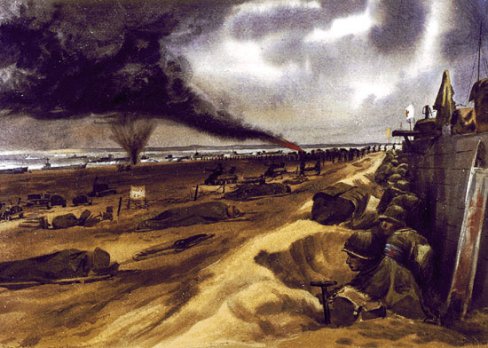
Utah Beach
“Members of an American landing party lend helping hands to other members of their organization whose landing craft was sunk be enemy action of the coast of France. These survivors reached Utah Beach, near Cherbourg, by using a life raft”.
General Cota was second in command of the 29th Infantry Division. He had little faith in the accuracy of air and naval bombardment, thought it would do little good, and had wanted to make the landing under cover of darkness.
Cota landed at 0730 with the main command group of the 116th, Company K. Several in his LCVP were killed immediately as the ramp went down. When Cota got to the sea wall he made an immediate and critical command decision. He saw at once that the plan to go up the draws was obsolete. It simply could not be done. Nor could the men stay where they were. They had to get over the shingle, get through the heavily mined swamp, and climb the bluff to drive the Germans from their trenches and take the draws from the inland side.
Lieutenant Shea described Cota’s actions:
“Exposing himself to enemy fire, General Cota went over the seawall giving encouragement, directions, and orders to those about him, personally supervised the placing of a BAR, and brought fire to bear on some of the enemy positions on the bluff that faced them. Finding a belt of barbed wire inside the seawall, General Cota personally supervised placing a bangalore torpedo for blowing the wire and was one of the first three men to go through the wire. At the head of a mixed column of troops he threaded his way to the foot of the high ground beyond the beach and started the troops up the high ground where they could bring effective fire to bear on the enemy positions.”
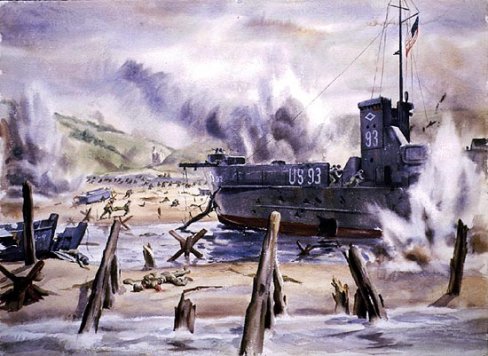
Although the lead elements of the assault had been on the beach for almost an hour, none had progressed farther than the seawall. Most were clustered under the wall, pinned down by machine-gun fire. The beach was jammed with dead and wounded. General Cota had landed to fine a completely stalled attack. He went to work immediately.
Once on the beach, General Cota did move from group to group, encouraging the men to begin to move.
“Don’t die on the beaches, die up on the bluff if you have to die, but get off the beaches or you’re sure to die.”
Cota found Schneider at his CP. Cota remained standing, even with the German firing; Schneider also stood up to converse. One witness remembers Cota saying to Schneider,”We’re counting on your rangers to lead the way.”
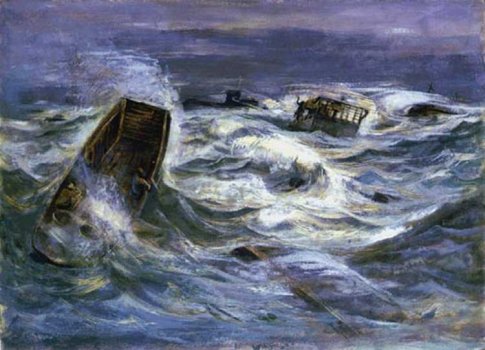
Omaha Beach
Father Joe Lacy
Father Lacy was described by one of the Rangers as a “small, old, fat Irishman.” But there he was, on the beach that first terrible morning, tending to the wounded.
The Rangers had insisted that he would never be able to keep up with them in combat. They were finely tuned and in great physical shape, he was not. But he had insisted in coming along. On the transport on the night of June 5-6, he told the others:
“When you land on the beach and you get in there, I don’t want to see anybody kneeling down and praying. If I do I’m gonna come up and boot you in the tail. You leave the praying to me and you do the fighting.”
Once on the beach, the men saw Father Lacy:
“go down to the water’s edge and pull the dead, dying, and wounded from the water and put them in relatively protected positions. He didn’t stop at that, but prayed for them and with them, gave comfort to the wounded and dying. A real man of god.”
On D-Day strange canvas covered bathtub looking vehicles came in from the ocean and landed on the beach. The vehicles were Sherman tanks fitted with a flotation device, which allowed them to drive off an LCT and into the ocean, and then navigate to the beach. One tank driver later said, “I still remember very vividly some of the machine gunners standing up in their posts looking at us with their mouths wide open.”
These tanks were the brainchild of Maj. General Percy Hobart of the British Army. The floating tank, These tanks were the brainchild of Maj. General Percy Hobart of the British Army.

The Real “Saving Private Ryan” & Colonel Vandervoort
Ste,-Mere-Eglise was a quiet village with a couple of hundred gray stone houses. It was a village in which nothing much of consequence had happened for ten centuries. The road N-13 ran through the village, heading north to Cherbourg and east to Caen and onto Paris. Without the use of N-13 the Germans to the north would be cut off. If the Americans lost control many paratroopers would be cut off and the 4th Infantry Division would be unable to move off the beach to the west and north. Because of this the battle for the little village took on a great importance.
Colonel Vandervoort, despite a broken ankle during the parachute drop and having to be moved around in a wheelbarrow, moved his battalion into the village. Between them and another battalion, they did not have the men form a complete defensive perimeter so they decided to only defend both ends of the main road.
About 1pm on D-Day a Frenchman rode his bicycle up to them and announced in English that some American paratroopers were bringing in a large contingent of German prisoners from the north. Sure enough, when Vandervoort looked in that direction there was a column of troops marching in good order right down the middle of N-13, with what appeared to be paratroopers on either side of them waving orange flags (the American recognition signal on D-day).
Vandervoort grew suspicious when he noticed two tracked vehicles at the rear of the column. He told one of his men to fire a short machine gun burst to the right of the column. Sure enough the “prisoners” and “paratroopers” both jumped into ditches and began to return fire. The Germans outnumbered the Americans five to one and began to flank his position. He sent for reinforcements and ordered the men to begin a fighting withdrawal.
Finally only sixteen of his forty three men were in a condition to fight and they were preparing for a “last stand”. Then a medic volunteered to stay behind and look after the wounded. Pvt. Julius Sebastain, Cpl. Ray Smithson, and Sgt. Robert Niland offered to form a rearguard to cover the retreat of the remainder of the platoon. The three were able to put up an energetic defense that actually stopped the German advance for a time and allowed the others to escape.
The twenty-eight badly wounded men which were left behind along with two of the three volunteers who stayed behind were captured. The third volunteer, Sgt. Bob Niland, was killed at his machine gun. One of his brothers, a platoon leader in the 4th Division, was killed the same morning at Utah Beach. Another brother was killed that week in Burma. Mrs. Niland received all three telegrams from the War Department announcing their deaths on the same day. Her fourth son, Fritz, was in the 101st Airborne and was pulled out of the front lines by the Army.
Lt. Col. Ben Vandervoort, and his 2nd Battalion (505th PIR, 82nd Airborne Division) later saw action at the Nijmegen bridge in Operation Market Garden (movie: A Bridge Too Far). His battalion was assigned to take the west end of the Nijmegen bridge while Maj. Julian Cook’s 3rd Battalion took the east end, crossing the river in the small boats.
The 82nd was to then later play a major role in the defense of the allied position during the Battle of the Bulge.
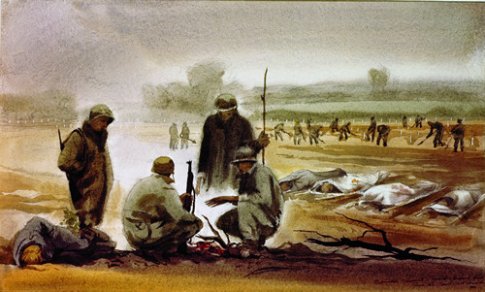
Normandy Burial Ground
St. Mere Eglise ,was the principal objective of the 82nd Airborne on the early morning of June 6. It was the site of three days of intense fighting as the Germans repeatedly counter attacked in attempts to retake the strategic town from the occupying American paratroopers. The village is perhaps best remembered for its church, in the center of the town square, where Paratrooper John Steel of the 505th PIR became trapped when his parachute was ensnared by a steeple. He watched helplessly as the rest of his company was killed by the waiting Germans.
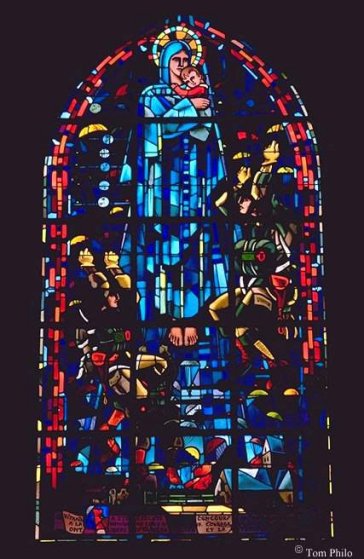
St. Mere Eglise
The stained-glass windows of the church are a tribute to those who liberated St. Mere Eglise:
* At the upper left are airborne wings.
* At the upper right is the parachute and glider that made up the badge of American Airborne Command.
* The lower left cut-out shows the insignia of the 82nd Airborne Division (AA for “All American Division”).
* The faint parachutes at the lower right are a constant motif in the windows.
* The symbol of the Free French (the Cross of Lorraine) is shown bottom center.
Wild Thing’s comment …….
We owe a tremendous debt of gratitude to those who gave their lives in this giant struggle and to those who were lucky enough to come back home.
We can only imagine the horror and the dying that took place. We need to perpetuate their story of sacrifice and glory for as long as we live.
Can you see the thousands of ships offshore that formed the most powerful armada that the world has ever seen? A huge salvo is being laid down prior to the invasion. Troops climb down rope ladders into landing craft. Many invasion force craft are circling around, grouping up, just before they make their final drive for the beach.
The Germans are entrenched in concrete bunkers and gun emplacements and are shelling the approaching landing craft. Many men never make it to the beach, but instead die in the churning surf. Those who do get to the beach and tumble out of their craft are subject to horrendous machine gun fire from pillboxes that rake the entire shore. There are the dead and the dying.
Valiant army engineers mount a superhuman effort to blow a hole in the concrete barricade so troops can move inland, away from the murderous fire coming from above them.
Those first few hours must have indeed been some of the longest ever faced by bold and courageous men. May their honor and sacrifice not be forgotten, and may this event in history go down not as just about death and dying, but as a turning point for the world, toward peace. God willing, it will never have to be repeated.




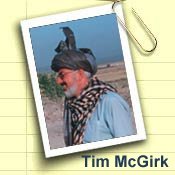
 Wild Thing’s comment……
Wild Thing’s comment……

















Recent Comments